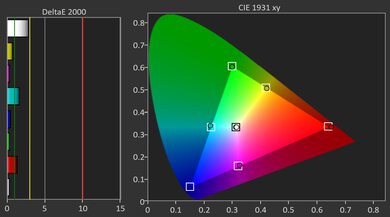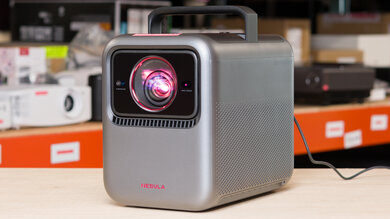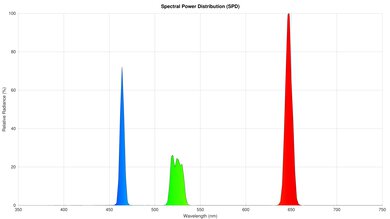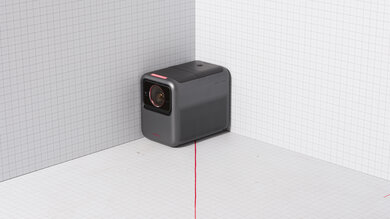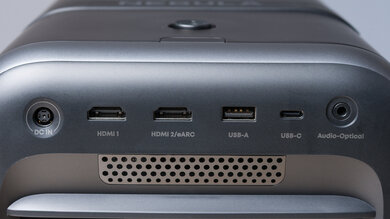The Anker Nebula X1 is a portable home theater projector primarily marketed for outdoor use. It's a medium-sized projector with a retractable handle for easy portability. It can be bought with an additional accessory pack containing a carrying case, a set of microphones for hosting duties or karaoke nights, and two extra wireless speakers, turning the unit into a true 200W speaker setup; without the extra speakers, the unit itself acts as a 40W speaker.
The unit has a full suite of image correction features, such as auto keystone and autofocus, alongside auto screen fit and an automatically tilting lens for easy positioning. The projector comes with Android OS 11, with official Netflix integration, and Dolby Vision support. It's capable of projecting an 80-inch image at a distance of 5.2 to 8.7 feet, up to a 300-inch image at 20 to 32.5 feet.
Our Verdict
The Anker X1 projector is excellent for watching movies. It's easily bright enough to be watched outside at night, even with some lights around. Its contrast is great, showing deep blacks in most scenes. It also has an extremely wide color gamut, even in HDR. The projector is also very accurate right out of the box, although our unit initially had strange visual artifacts, which disappeared after a settings reset. Ultimately, this is an extremely versatile projector that can both act as a home theater unit or a high-quality portable model.
Easily bright enough for dim conditions.
Deep blacks in most content.
Very wide color gamut.
Fully featured projector, with official Netflix and Dolby Vision support.
A ton of image correction features, alongside a retractable handle, makes for easy portability.
Very easy to calibrate.
Unit initially had strange visual artifacts before a settings reset.
The Anker X1 is a decent choice for living-room and backyard gaming sessions. It has exemplary picture quality, as it's extremely bright and has impressive contrast. Plus, it's extremely colorful in SDR and HDR. Finally, it's very accurate out of the box, so you don't need to get it calibrated. It also supports Dolby Vision, a boon for Xbox gamers. As for performance, it's capped at 60Hz, but Game Mode keeps controls fast enough for slower single-player titles. Competitive players will still prefer a true 120Hz projector, especially as the unit's input lag is just too slow for quicker titles, such as platformers or most shooters.
Easily bright enough for dim conditions.
Deep blacks in most content.
Very wide color gamut.
A ton of image correction features, alongside a retractable handle, makes for easy portability.
Has Dolby Vision.
Unit initially had strange visual artifacts before a settings reset.
Its input lag is just not quick enough for faster titles.
No 120Hz support.
Changelog
-
Updated Oct 03, 2025:
We made some minor adjustments before our official TBU 0.10 launch.
-
Updated Oct 03, 2025:
We've added text to the Imaging, Optics, Noise, Supported Resolutions, HDR Format Support, 3D, Input Lag, and Audio Passthrough boxes as a result of our latest test bench. We've also added Gaming and Game Mode Responsiveness usages in the Verdict section.
- Updated Oct 03, 2025: We've converted the review to Test Bench 0.10, which updates our Design tests, and adds a whole new suite of Inputs tests. We also added new gaming-oriented usage scores in Our Verdict. See the 0.10 changelog.
-
Updated Aug 27, 2025:
We mentioned the newly reviewed Anker Nebula Mars 3 and added a mention of it in the Portability section.
Check Price
Differences Between Sizes And Variants
The Anker Nebula X1 projector is currently the only option in Anker's X Series. It can be bought stand-alone or alongside an accessory kit, which includes two microphones, a carrying case, and a set of wireless speakers that transform the projector into a full-blown sound system.
Our unit was manufactured in April 2025.
Popular Projector Comparisons
The Nebula X1 is a tremendous projector with a rather unique use case: a mid-size home theater-grade projector with an integrated handle that's primarily marketed to be used outside. Alongside its handle, the unit has a full suite of image correction features, all to make sure it can easily be carried around. This means that it combines the strengths of some home theater products, like the Valerion VisionMaster Pro 2 or the Epson Home Cinema 3800, with portable products like the Samsung The Freestyle 2nd Gen or the XGIMI MoGo 2 Pro. Ultimately, the Anker is leagues above any other portable product, making it an interesting option for anyone looking for a high-quality portable projector.
For more, check out our recommendations for the best 4k projectors, the best projectors for home theater, and the best portable projectors. If you're really looking for a product to use outside, consider the best outdoor projectors as well.
The Anker Nebula X1 and Hisense C2 Ultra projectors perform very similarly, with the Anker having a very slight edge. The Anker is a bit brighter, with slightly deeper contrast, and is a bit more accurate out of the box, but they're extremely close. They're equally portable, but they go about it in different ways: the Hisense has a gimbal stand, which lets you fully adjust its viewing angle, while the Anker has an integrated handle and a motorized lens.
The Valerion VisionMaster Pro 2 and Anker Nebula X1 are similar projectors, although the Anker is a bit better overall. While the Anker is specifically marketed for its portability and outdoor use, as it has a retractable handle and a full suite of image correction features, the Valerion also comes with a carrying case, making it almost as portable. Still, the Anker offers more options, especially if you opt to buy its accessory pack, which transforms the unit into a full-blown sound system. It also has slightly better image quality overall. Ultimately, what you're looking for is likely to dictate your purchase: those looking for a pure home theater solution will lean toward Valerion, and those hoping for a more versatile option will lean toward Anker.
The Samsung The Freestyle 2nd Gen is a smaller and more portable projector than the Anker Nebula X1, but it's also far worse when it comes to image quality. The Anker is also much more expensive, so even though they're both portable products, they really belong to different market segments. If you're looking for the smallest projector possible, the Samsung fits that bill, but if you're looking for a portable projector that can also double as a home theater option, the Anker is far better.
The BenQ X3100i and Anker Nebula X1 perform similarly, but they don't have the same use case. The BenQ is a gaming projector that can also double as a home theater unit; this means that it comes with a full suite of gaming features, which the Anker lacks. Inversely, the Anker is marketed as a home theater-grade portable projector, with a retractable handle and a full suite of image correction features. The Anker is a bit punchier when it comes to image quality, especially due to its superior contrast. Ultimately, those looking for a unit capable of some serious gaming will prefer the BenQ, but those looking for more punch, or who want to be able to easily carry the unit, will prefer the Anker.
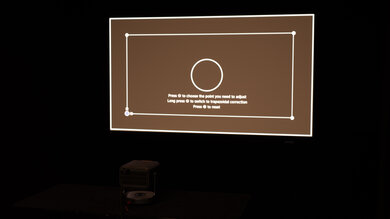
We've independently bought and tested over 60 projectors, and we've published all the detailed results for each so you can decide which one to buy. These have all been tested under the same standardized methodology, allowing you to compare them side by side. We still have all these projects in our lab so we can continually go back and compare them to ensure our reviews are still accurate. All our test methodology is also public on our website, so you can validate the results yourself.
Throw Calculator
Global Controls
Test Results

The Anker X1's brightness is excellent. Its best trait is its fantastic brightness uniformity; the sides of the screen are almost just as bright as the center, leading to an immersive viewing experience without any dark spots. The projector's white light output, namely how bright it gets, is amazing. It's certainly bright enough for dark rooms, and can even handle some moderately lit rooms without washing out. Its colors are great, as the projector is bright enough to project vibrant hues.
Our results are with the iris level set to maximum. When set to minimum, the projector isn't as bright, but has better contrast. Here are brightness measurements with the iris set to minimum:
- White Light Output: 1,544 Lumens
- Color Light Output: 1,533 Lumens
- Brightness Uniformity: 97%
- Screen Brightness: 175 nits
The Nebula X1's contrast ratio is great with almost all content. It falters a little bit in very high APL scenes, but it's still satisfactory. Overall, this projector's contrast delivers an impressive viewing experience in darker rooms.
Prior to a settings reset, we had a very noticeable bug with the Contrast setting, at least with Firmware version 11.0.44. When contrast was set to its default 50, the projected image had artifacts in the form of rectangular geometric shapes, the screen looked extremely red, and was clipping whites. You had to drop the contrast to 45 to fix it. Now most of this has been resolved after the reset, even if there is still a slight red tint to the image when contrast is set to 50.
Our results are with the iris level set to maximum. When set to minimum, the projector isn't as bright, but has better contrast. Here are contrast measurements with the iris set to minimum:
- 1% APL Native Contrast: 1,750 : 1
- 5% APL Native Contrast: 1,068 : 1
- 10% APL Native Contrast: 640 : 1
- 15% APL Native Contrast: 448 : 1
- 25% APL Native Contrast: 277 : 1
- 50% APL Native Contrast: 142 : 1
After a settings reset, the Anker X1's pre-calibration accuracy in SDR is great. Its color accuracy, in particular, is almost right on the money; almost all colors are on target, and there aren't many color mapping issues. The unit's white balance is very good, with some blues being slightly overrepresented in some grays, and reds being a bit underrepresented in other grays. It does make the projector's color temperature too cool out of the box.
For another option with similar pre-calibration SDR accuracy, consider the Hisense C2 Ultra.
The Anker X1 is easy to calibrate with an 11-point white balance and full color calibration. Doing so significantly improves the unit's accuracy and fixes most of its issues.
The Anker X1 projector uses a laser light source that lasts more than 30,000 hours and needs almost no upkeep. It isn't native 4k, as it uses pixel-shifting to simulate a higher-resolution image, but it still looks crisper than a regular 1080p projector.
The SPD shows narrow, spike-like red/green/blue peaks typical of RGB laser light engines. In practice, you get very pure primaries and punchy, saturated colors, with minimal long-term dimming, and no lamp replacements. The trade-off is that some screens/rooms may show mild laser speckle.
The Anker Nebula X1 projector is a short-to-standard throw unit with motorized zoom and quick autofocus, alongside full auto keystone, but it's better to set up the projector manually, as keystone harms image quality. Here are some common throw distances:
- 80″: ~5.2–8.7 ft
- 90″: ~5.9–9.8 ft
- 100″: ~6.5–10.9 ft
- 120″: ~7.8–13.1 ft
- 150″: ~9.8–16.3 ft
- 200″: ~13.1–21.8 ft
- 300″: ~20–32.5 ft
Anker says that the projector's IEA (Intelligent Environment Adaptation) features work best at 13 feet, which encompasses screen sizes from 120 to 200 inches.
The Anker X1 is quite portable for a medium-sized projector. It has an integrated handle that slides out upon being pressed. It also has a full suite of image correction features, including auto keystone and autofocus, alongside an automatically tilting lens. Unfortunately, it doesn't have a built-in battery, so you'll need a power source of some kind if you want to take it outside.
The unit has a 40W sound system. You can also purchase a separate accessory pack with additional wireless speakers, transforming the projector into a 200W sound system. In that arrangement, the projector itself acts like a subwoofer. The accessory pack also includes a set of microphones and a carrying case.
If you don't need a projector with top-notch image quality and would instead like it to resist bad weather when taken outdoors, consider the Anker Nebula Mars 3.
Fan noise is subdued for a bright portable. In a quiet room, you'll hear it spin up at max brightness, but dialogue and game audio easily mask it at normal listening levels.
Two HDMI inputs handle a streamer/console combo nicely, and eARC on the second HDMI lets you feed a soundbar/AVR. USB-A/USB-C cover local media or power for a stick, and Wi-Fi handles built-in apps. There’s no Ethernet, so if your router is far, plan on strong Wi-Fi or a mesh node.
The Anker Nebula X1 is a 60Hz projector. Consoles and PCs handshaking at 4k/60 and 1080p/60 are seamless, and 1080p/60 in full 4:4:4 keeps PC text crisp. Still, no 120Hz support limits this unit to more casual gaming or for playing slower single-player titles.
The unit's Game Mode is alright for slower single-player titles, but it's too slow for faster titles. When you step out of Game Mode, input lag jumps dramatically, making it unusable for any gaming.
The unit's eARC works, but its behavior is quirky: it reliably carries Dolby formats (including DD+ Atmos), while some 7.1 streams get downmixed to 5.1 with the default "Auto" audio option. There's no DTS passthrough.








